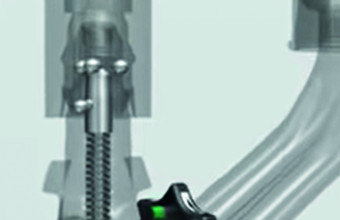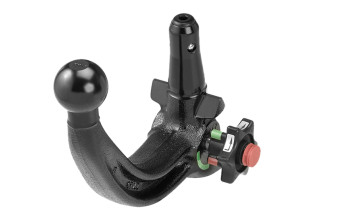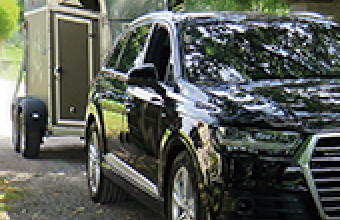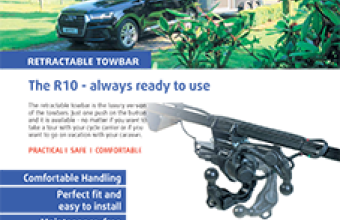
Towing a Horse Trailer Safely
Towing with a horse trailer can be much more stressful than towing a trailer or caravan as you are responsible for a live animal in the back. It's not just your life you have to worry about, but that of your horse as well. That's why it is crucial to make sure your towbar is inspected and maintained regularly and in full working order before you attach your horsebox and set off. To help you along the way, we have covered the following tips so you can tow safely with a horse trailer:
What vehicle do I need to tow a horsebox?
What towbar do I need?
Horse trailer safety
Maintaining your towbar
Towing regulations
What to do before setting off
What vehicle do I need to tow a horsebox?
To safely tow a horsebox, your vehicle needs to have a towing capacity that can safely pull the horsebox. Generally, horse trailers weigh between 2000kg – 2700kg when loaded, so a vehicle that can legally and safely tow this weight is advised. Usually SUV, 4x4 or pickup style vehicles are best for towing a horse trailer but you should always check the towing capacity of your particular towing vehicle.
What towbar do I need to tow a horsebox?
Fixed and detachable towbars are suitable for most vehicles and are designed to the vehicle manufacturer's specifications on towing. For example, if your vehicle can tow a 2750kg braked trailer then the towbar will be designed to do this safely.
Whatever type you choose, having the right towbar fitted is extremely important. It should be a new towbar, not second-hand, and it is never advisable to use a towbar from another vehicle as its history is unknown. The towbar should be designed for the specific make and model of your vehicle along with the towbar electrics kit. These work in sync with your vehicle's towing-related safety features and it is essential that they are correctly installed by a professional fitter in line with manufacturer guidelines.
Horse trailer safety
Before you even think about towing a horse trailer, there are lots of things you need to check first including the combined weight of the horse, trailer and kit, your vehicle's towing capacity and vehicle safety checks.
Horse trailer weight
The weight of your horse trailer will inevitably vary depending on the size of your trailer and the size of your horse. However, they usually range from around 720kg for a single-horse trailer to around 950kg for a double-horse trailer. This is important to note when buying your trailer, towing vehicle or even your horse because you need to ensure your vehicle is capable of towing the combined weight of the trailer, horse and your kit.
As an example, a double-horse trailer might have an unladen weight of 900kg. If you then add in two horses weighing roughly 650kg each plus around 100kg of kit, you'll need a vehicle with a towing capacity of at least 2,300kg. If you want to transport multiple horses with even more kit and cannot find a suitable towing vehicle, you may be better off looking for a horsebox with living quarters to fulfil your needs.
Maintaining your towbar
Whether you have a fixed or detachable towbar, it is important to maintain your towbar. Detachable towbars require more regular care but either type should be well maintained.
Towing regulations
There are rules and regulations around what you can safely tow and it should take into account the fully loaded trailer weight, including the weight of your horse and all of your kit. To tow a trailer and horses safely, you should adhere to the following guidance:
A fully loaded trailer weighing up to 3,500kg MAM if you got your driving licence after 1 January 1997
A combined maximum weight of the trailer and towing vehicle of 8,250kg MAM if you got your licence before 1 January 1997
In addition, you also need to make sure that your towing vehicle has a towing capacity and capability of towing the combined weight of your fully loaded horse trailer so you can safely travel with your four-legged friend. You can learn more about how to work out your towing capacity here.
What to do before setting off
Before you set off on your journey, there are lots of things you should check on your car and trailer to ensure the safety of yourself, your horse and other vehicles on the road.
Horse trailer safety checklist
Internal trailer
Lift the rubber matting and ensure the flooring is intact, clean and dry. It should be mucked out after each use
Check the roof for signs of leaks and ensure the doors, hinges and locking mechanisms are working properly
Make sure the breast bars and partitions are working safely, as they should be
Check that any spare wheels are not damaged and are in good working order
External trailer
Check the tyre pressure of each tyre and look for any splits, cracks and ensure the tread is no less than 1.66mm
Make sure the number plate is secured and is the same as what is on the towing vehicle
Look for any signs of wear and tear
Ensure the reflectors are clean, clear and all of the lights are working correctly in sync with the vehicle electrics
Internal vehicle
Make sure the oil, water and washer fluid is topped up to the right level
Pack a first aid kit for both you and your horse
Do not travel without your horse's passport
Make sure you have breakdown cover, snacks, a blanket, high-vis jacket, a torch and a warning trailer in case you break down
External vehicle
Check the tyre pressure of each tyre and look for any splits, cracks and ensure the tread is no less than 1.66mm
Test the brakes, handbrake, lights and indicators before setting off and make sure these are working correctly on the trailer
Ensure the wing mirrors are wide enough to see around the trailer
Check the weight of your combined horse, trailer and kit does not exceed your vehicle's towing capacity and what you can legally tow
Make sure the brake is off, the jockey wheel is raised and the breakaway cable is correctly and securely attached when coupling up
Check that any spare wheels are not damaged and are in good working order
Your horsebox also needs maintaining on an annual basis which should be carried out by a qualified trailer specialist. This helps to keep your horsebox in top condition, giving you the confidence to tow for many years.
And that's it - all you need to know to get your horsebox on the road. We hope you found that useful. If you're looking for towing equipment, feel free to take a look at Westfalia Automotive's wide range of towbars, electrical kits and accessories. Happy towing!




